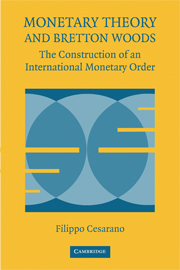Book contents
- Frontmatter
- Contents
- Preface
- Acknowledgments
- 1 INTRODUCTION
- 2 INTERNATIONAL MONETARY EQUILIBRIUM AND THE PROPERTIES OF THE GOLD STANDARD
- 3 THE INTERNATIONAL MONETARY SYSTEM BETWEEN THE WORLD WARS
- 4 THE MONETARY SYSTEM IN ECONOMIC ANALYSIS: THE CRITIQUE OF THE GOLD STANDARD
- 5 THE GREAT DEPRESSION: OVERTURNING THE STATE OF THE ART
- 6 PROVIDING FOR A NEW MONETARY ORDER
- 7 THE BRETTON WOODS AGREEMENTS
- 8 BRETTON WOODS AND AFTER
- References
- Author Index
- Subject Index
7 - THE BRETTON WOODS AGREEMENTS
Published online by Cambridge University Press: 18 December 2009
- Frontmatter
- Contents
- Preface
- Acknowledgments
- 1 INTRODUCTION
- 2 INTERNATIONAL MONETARY EQUILIBRIUM AND THE PROPERTIES OF THE GOLD STANDARD
- 3 THE INTERNATIONAL MONETARY SYSTEM BETWEEN THE WORLD WARS
- 4 THE MONETARY SYSTEM IN ECONOMIC ANALYSIS: THE CRITIQUE OF THE GOLD STANDARD
- 5 THE GREAT DEPRESSION: OVERTURNING THE STATE OF THE ART
- 6 PROVIDING FOR A NEW MONETARY ORDER
- 7 THE BRETTON WOODS AGREEMENTS
- 8 BRETTON WOODS AND AFTER
- References
- Author Index
- Subject Index
Summary
The impelling objective of reconstructing the international monetary system provided the driving force for framing an agreement starting from the quite different approaches of the Keynes and White plans. The sheer diversity of these proposals required a major effort, both analytical and at the negotiating table, to arrive at a shared solution, but the goal was pursued with determination and confidence. Setting out the main features of the International Clearing Union before the House of Lords on 18 May 1943, Keynes noted: “I have not the slightest doubt in my own mind that a synthesis of the two schemes should be possible” (CW 25, 279).
The round of intense negotiations, which a year later produced the Joint Statement of 21 April 1944, was decisive. In fact, that document contained all the essential elements of the Articles of Agreement approved at Bretton Woods just three months on. The numerous, punctilious discussions served to narrow the distance separating the British and American positions and produce a draft that could be acceptable to other nations as well. In a sense, the road to the Joint Statement was the real negotiation over the postwar monetary order: The Bretton Woods conference settled many questions of detail, but essentially adopted that blueprint.
THE JOINT STATEMENT AND THE ORGANIZATION OF THE CONFERENCE
Work on a synthesis of the British and American proposals started soon after their publication.
- Type
- Chapter
- Information
- Monetary Theory and Bretton WoodsThe Construction of an International Monetary Order, pp. 159 - 187Publisher: Cambridge University PressPrint publication year: 2006



